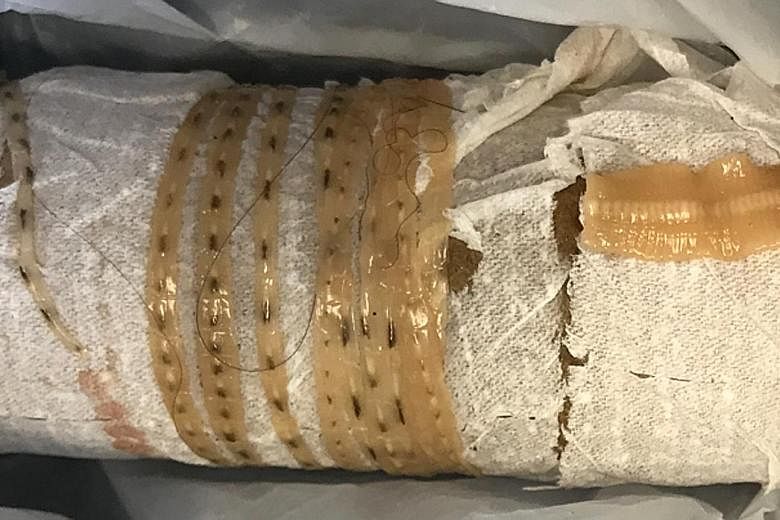WASHINGTON • He told an emergency room physician he had a liking for raw fish - specifically, salmon sashimi.
It's what the 30-year-old man from Fresno, California, suspected had landed him in the bathroom with stomach cramps and bloody diarrhoea.
But what he did not anticipate was the moment he spotted something hanging from his rear end. Naturally, he assumed the worst.
"He was like, 'Oh my goodness, my guts are coming out from me,'" said Dr Kenny Banh, the emergency physician at the University of California at San Francisco (UCSF), in Fresno, who treated him.
Dr Banh recounted what the man told him on the podcast "This Won't Hurt A Bit" earlier this month.
He gave it a pull, Dr Banh said, and it kept coming. "He picks it up and looks at it and what does it do? It starts moving," he said. "He was like, 'That's a worm.'"
It was a Monday in August last year when the man showed up in the emergency room of UCSF Fresno's Community Regional Medical Centre clutching a plastic grocery bag and asking doctors to treat him for tapeworms - parasites that can invade the digestive tract of animals and humans.
-
Parasites from seafood
-
Humans are most likely to be infected with parasites like worms when they eat uncooked or undercooked seafood that contains parasite larvae.
The larvae begin growing once they are inside the host.
COMMON PARASITES IN SEAFOOD
• Roundworms: They have a long round body, and vary in length from several millimetres to 2m
• Tapeworms: A type of flatworm ranging in size from about 1mm to over 15m
• Flukes: A flatworm, and most range from 5mm to several centimetres long
SYMPTOMS OF PARASITIC INFECTION
• Stomach cramps, nausea, vomiting and diarrhoea
• Weight loss
• Anaemia
• Damage to major organs like the liver and heart
• Damage to the central nervous system
DISHES THAT COULD CAUSE PARASITIC INFECTIONS
• Ceviche, a Latin American dish with raw fish
• Herring roe
• Sashimi and sushi
• Drunken crabs
• Cold smoked fish
HOW TO KILL PARASITES
• By thoroughly cooking seafood
• By freezing seafood at specified temperatures for prescribed periods, depending on the type of parasite. Flukes, for example, are more resistant to freezing than roundworms.
SOURCE: US FOOD AND DRUG ADMINISTRATION
Dr Banh said he didn't think too much of it; he had heard patients express similar concerns about tapeworms in the past.
Dr Banh opened the plastic bag. Inside, he said, was a cardboard toilet paper tube with a tapeworm wrapped around it.
The doctor said the worm was dead when he saw it but noted that the man told him it was alive and wriggling when he pulled it out.
Dr Banh stretched it out on the ER floor and measured it - all 1.6m of it, he said in an interview last Friday with The Washington Post. "It got long enough that some of it was sneaking out of him," he said about the parasite.
Dr Banh said it is not certain which species of tapeworm it was or how long it had been inside the patient. According to the United States Centres for Disease Control, tapeworms can grow up to 9m and live for years.
He said his patient was convinced he got the tapeworm from eating raw fish.
Given the fact that the man had not recently travelled or been drinking questionable water - and the fact that he said he ate sushi or sashimi almost daily - the doctor is "almost positive" that the self-assessment is correct.
However, Dr Banh said, there are risks with any type of food.
"You have to be aware," he said, explaining that the concern is not with the sushi or sashimi, but with whether it is properly prepared.
The US Food and Drug Administration has released guidelines for controlling parasites that may live in seafood - by cooking the food or freezing it at certain temperatures for certain amounts of time.
The patient was given medication to kill any other tapeworms, Dr Banh said, but no others came out.
"He swore off sushi after this," Dr Banh said. But the doctor predicted that eventually, his patient will eat it again.
WASHINGTON POST

